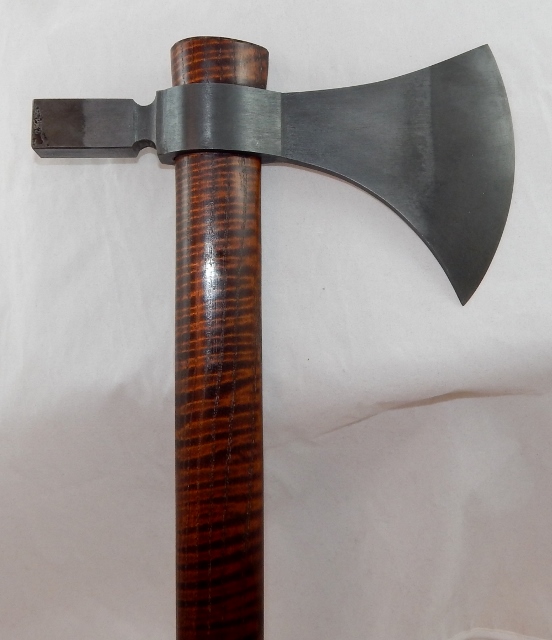

Cold steel tomahawk plus#
Each SSGN is capable of carrying 154 Tomahawk cruise missiles, plus a complement of Harpoon missiles to be fired through their torpedo tubes.Īs part of the New START treaty, four tubes on each SSBN will be deactivated, leaving each ship with only 20 available for war loads. Each SSBN submarine is armed with up to 24 Trident II submarine-launched ballistic missiles (SLBM). The SSBN submarines provide the sea-based leg of the U.S. The US Navy has a total of 18 Ohio-class submarines which consist of 14 ballistic missile submarines (SSBNs), and four cruise missile submarines (SSGNs). The sections were produced at the General Dynamics Electric Boat facility, Quonset Point, Rhode Island, and then assembled at its shipyard at Groton, Connecticut.

The Ohio-class submarines were constructed from sections of hull, with each four-deck section being 42 ft (13 m) in diameter.
Cold steel tomahawk mod#
Fire control for their Mark 48 torpedoes is carried out by Mark 118 Mod 2 system, while the Missile Fire Control system is a Mark 98. These submarines are reported to be as quiet at their cruising speed of 20 knots (37 km/h 23 mph) or more as the previous Lafayette-class submarines at 6 knots (11 km/h 6.9 mph), although exact information remains classified. The class's design allows the boat to operate for about 15 years between major overhauls. USS Michigan (SSBN-727) at a dry-dock in November 2002, before its conversion to an SSGN.

Ohio was virtually undetectable in her sea trials in 1982, giving the U.S. Moreover, the "stealth" ability of the submarines was significantly improved over all previous ballistic-missile subs. These hatches allow rapid transfer of supply pallets, equipment replacement modules, and machinery components, speeding up replenishment and maintenance of the submarines. To decrease the time in port for crew turnover and replenishment, three large logistics hatches have been installed to provide large-diameter resupply and repair access. Each submarine is assigned two complete crews, called the Blue crew and the Gold crew, each typically serving 70-to-90-day deterrent patrols. The Ohio-class submarine was designed for extended strategic deterrent patrols. The Ohio class is to be gradually replaced by the Columbia class beginning in 2031. Navy tradition had previously reserved for battleships and cruisers. All the Ohio-class submarines, except for USS Henry M. The lead submarine of this class is USS Ohio. Although the Trident missiles have no preset targets when the submarines go on patrol, : 392 they can be given targets quickly, from the United States Strategic Command based in Nebraska, using secure and constant radio communications links, including very low frequency systems. The 14 SSBNs together carry about half of U.S. Air Force strategic bombers and intercontinental ballistic missiles. Like its predecessor Benjamin Franklin- and Lafayette-class subs, the Ohio SSBNs are part of the United States' nuclear-deterrent triad, along with U.S. The Ohios carry more missiles than either: 24 Trident II missiles apiece, versus 16 by the Borei class (20 by the Borei II) and 20 by the Typhoon class.

They are the world's third-largest submarines, behind the Russian Navy's Soviet-designed 48,000-ton Typhoon class and 24,000-ton Borei class. Each displacing 18,750 tons submerged, the Ohio-class boats are the largest submarines ever built for the U.S. The Ohio class of nuclear-powered submarines includes the United States Navy's 14 ballistic missile submarines (SSBNs) and its four cruise missile submarines (SSGNs). General characteristics (SSGN conversion)Ģ2 tubes, each with 7 Tomahawk cruise missiles, totaling 154 General characteristics (SSBN-734 and subsequent hulls upon construction, SSBN-730 to SSBN-733 since refueling)Ģ4 × Trident II D5 SLBM with up to 12 MIRVed W76 or W88 (475 kt TNT) nuclear warheads each, range 6,100 nmi (11,300 km 7,000 mi) General characteristics (SSBN-726 to SSBN-733 from construction to refueling)Ģ4 × Trident I C4 SLBM with up to 8 MIRVed 100 kt TNT W76 nuclear warheads each, range 4,000 nmi (7,400 km 4,600 mi) BQQ-6 passive bow-mounted array (which includes BQS-13 fire control array) Ĥ × 21 inch (533 mm) Mark 48 torpedo tubes (Forward Compartment 4th level).25 knots (46 km/h 29 mph) submerged (reported).20 knots (37 km/h 23 mph) submerged (official).USS Ohio, during her commissioning ceremony in 1981.


 0 kommentar(er)
0 kommentar(er)
